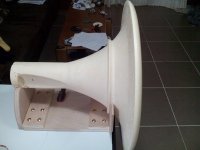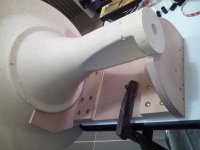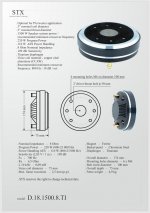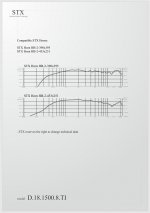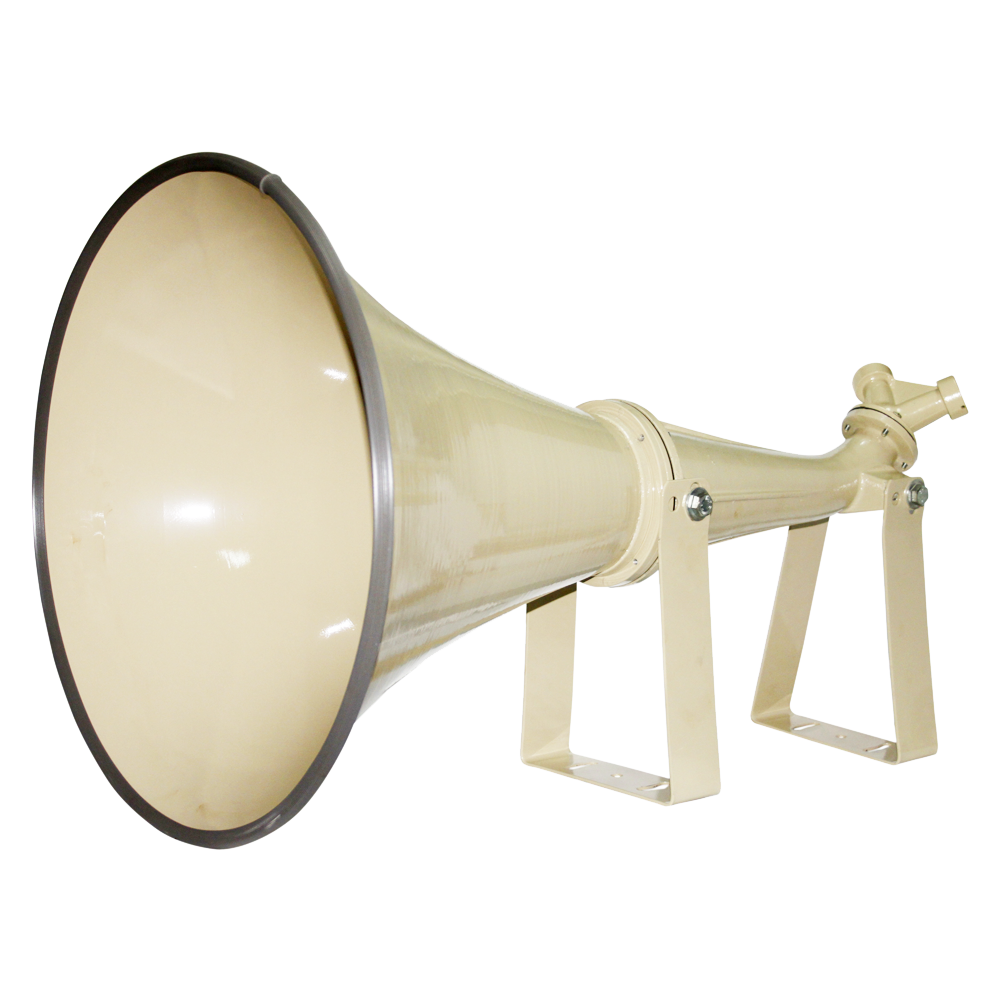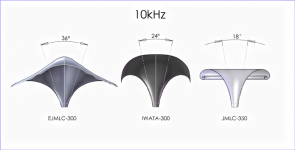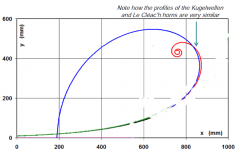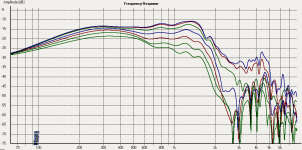Sorry, I meant on a passive network between bass and mid/high. Does that still hold true?
I was referring to mabat saying “having too high sensitivity is not a good thing because of the noise”. Then how does he deal with this when he is designing the passive network which includes a mid/high horn channels that would likely have even higher sensitivity (ie. lots more ‘noise’) than the bass drivers?
I was referring to mabat saying “having too high sensitivity is not a good thing because of the noise”. Then how does he deal with this when he is designing the passive network which includes a mid/high horn channels that would likely have even higher sensitivity (ie. lots more ‘noise’) than the bass drivers?
Last edited:
Sensitivity of a compression driver is very misleading. That's because of how they test it (various methods.)
In my NS-15, the only compression driver in B&Cs lineup that could come up to the sensitivity of the woofer (15NBX100) at 10 kHz was a de250. This is always true on a constant directivity device because the radiated power, i.e. sensitivity, is covering a much wider area than a directive horn, i.e. the SPL has to fall at the high frequency end. So, you see, there is sensitivity to burn for a powerful woofer when matched with a true CD device.
If I hadn't been drinking I'd give you all the details.
In my NS-15, the only compression driver in B&Cs lineup that could come up to the sensitivity of the woofer (15NBX100) at 10 kHz was a de250. This is always true on a constant directivity device because the radiated power, i.e. sensitivity, is covering a much wider area than a directive horn, i.e. the SPL has to fall at the high frequency end. So, you see, there is sensitivity to burn for a powerful woofer when matched with a true CD device.
If I hadn't been drinking I'd give you all the details.
Last edited:
Cheers Dr. Geddes!
(I just opened a bottle of Warsteiner 😉)
BTW, have you ever experimented with coaxial compression drivers, like the DCX50 for instance?
(I just opened a bottle of Warsteiner 😉)
BTW, have you ever experimented with coaxial compression drivers, like the DCX50 for instance?
Last edited:
camplo, I'm the kid who would ask the obvious questions (because I am often slow to catch onto things). Only way I can learn 😀
Does Tony Gee's words in his documentation on his Calpamos speaker, factually incorrect and hold no merit with regards to woofer choice for a choosing a "PA woofer" for "domestic" 2-way speaker? 😕
http://www.humblehomemadehifi.com/download/Humble Homemade Hifi_Calpamos.pdf
"PRO DRIVERS
As stated, the Calpamos is a two-way loudspeaker. It uses a 15-inch midwoofer in combination with a 2-inch compression driver
that is coupled to a bi-radial horn. When choosing suitable pro drivers for a domestic hifi loudspeaker there a few parameters that
have to be taken into consideration. In regards to woofers and midwoofers we are looking for a driver that has low mechanical
losses, low moving mass and a low resonance frequency. Low mechanical losses are important when playing music at low sound
levels. If the losses are too high you get a speaker that doesn't "open up" unless it is played loudly. Then there is a low moving
mass to take into account. I have found that a relatively low moving mass contributes to good articulation in the midrange - vital
for a high quality two-way loudspeaker. There is no need for thick, heavy cones here - we are not building a subwoofer! And of
course a low resonance frequency is essential for decent bass reproduction."
"The 15FH500 and 15FH510 both have a relatively high moving mass Mms of 104 and 108 grammes respectively. The Mms of the
15PR400 is only 85,2 grammes. The 500 series woofers do have stronger magnets (higher BL) and stiffer suspension (lower Cms)
to compensate for the higher moving mass but I am looking for am agile sports car here, not a heavy muscle car. Think
Donkervoort D8 instead of Dodge Challenger (no offense to any muscle car owners). If you calculate the acceleration factor of the
three midwoofers (divide BL by Mms) then the 15PR400 has the best acceleration factor even though it has the "weakest" magnet
of the three.
One way of checking if a driver has low mechnical losses is to look at the impedance peak at the resonance frequency. If it is low
and wide then the driver has high mechanical losses, if it shows a high and narrow, sharp spike, then we are looking at a woofer
with low mechanical losses. All three of these Faital Pro 15-inch midwoofers have a 3-inch voice coil with an Re of 5,1 ohms but
when we look at the impedance peak at free air resonance Fs, we see that both the 15FH500 and 15FH510 are peaking at around
87 ohms where as the 15PR400 has a nice sharp impedance peak of about double that value at 170 ohms. To me an impedance
curve says more than a thousand words ;-) So the 15PR400 it will be.
The Faital Pro 15PR400 midwoofer has an impregnated, light-weight paper cone that is driven by a 3-inch / 77mm voice coil. The
voice coil former is made from glass fibre resulting in low losses inside the magnetic field. This is essential when maintaining detail
at low SPL's. Further high-lights are a light-weight neodymium magnet, low moving mass and low voice coil inductance. All these
parameters are important when looking for high quality, smooth and expressive midrange.
And last but not least a low resonance
frequency of 35Hz in combination with a Qts of 0,32 are ideal for good bass response in a not too large cabinet. If you are only
used to "normal" hifi loudspeakers, 35Hz might not seem that low for a woofer of this size, but trust me, 35Hz from a 15-inch
midwoofer sounds totally different to 35Hz from a 7-inch midwoofer. Size does matter!
"
Does Tony Gee's words in his documentation on his Calpamos speaker, factually incorrect and hold no merit with regards to woofer choice for a choosing a "PA woofer" for "domestic" 2-way speaker? 😕
http://www.humblehomemadehifi.com/download/Humble Homemade Hifi_Calpamos.pdf
"PRO DRIVERS
As stated, the Calpamos is a two-way loudspeaker. It uses a 15-inch midwoofer in combination with a 2-inch compression driver
that is coupled to a bi-radial horn. When choosing suitable pro drivers for a domestic hifi loudspeaker there a few parameters that
have to be taken into consideration. In regards to woofers and midwoofers we are looking for a driver that has low mechanical
losses, low moving mass and a low resonance frequency. Low mechanical losses are important when playing music at low sound
levels. If the losses are too high you get a speaker that doesn't "open up" unless it is played loudly. Then there is a low moving
mass to take into account. I have found that a relatively low moving mass contributes to good articulation in the midrange - vital
for a high quality two-way loudspeaker. There is no need for thick, heavy cones here - we are not building a subwoofer! And of
course a low resonance frequency is essential for decent bass reproduction."
"The 15FH500 and 15FH510 both have a relatively high moving mass Mms of 104 and 108 grammes respectively. The Mms of the
15PR400 is only 85,2 grammes. The 500 series woofers do have stronger magnets (higher BL) and stiffer suspension (lower Cms)
to compensate for the higher moving mass but I am looking for am agile sports car here, not a heavy muscle car. Think
Donkervoort D8 instead of Dodge Challenger (no offense to any muscle car owners). If you calculate the acceleration factor of the
three midwoofers (divide BL by Mms) then the 15PR400 has the best acceleration factor even though it has the "weakest" magnet
of the three.
One way of checking if a driver has low mechnical losses is to look at the impedance peak at the resonance frequency. If it is low
and wide then the driver has high mechanical losses, if it shows a high and narrow, sharp spike, then we are looking at a woofer
with low mechanical losses. All three of these Faital Pro 15-inch midwoofers have a 3-inch voice coil with an Re of 5,1 ohms but
when we look at the impedance peak at free air resonance Fs, we see that both the 15FH500 and 15FH510 are peaking at around
87 ohms where as the 15PR400 has a nice sharp impedance peak of about double that value at 170 ohms. To me an impedance
curve says more than a thousand words ;-) So the 15PR400 it will be.
The Faital Pro 15PR400 midwoofer has an impregnated, light-weight paper cone that is driven by a 3-inch / 77mm voice coil. The
voice coil former is made from glass fibre resulting in low losses inside the magnetic field. This is essential when maintaining detail
at low SPL's. Further high-lights are a light-weight neodymium magnet, low moving mass and low voice coil inductance. All these
parameters are important when looking for high quality, smooth and expressive midrange.
And last but not least a low resonance
frequency of 35Hz in combination with a Qts of 0,32 are ideal for good bass response in a not too large cabinet. If you are only
used to "normal" hifi loudspeakers, 35Hz might not seem that low for a woofer of this size, but trust me, 35Hz from a 15-inch
midwoofer sounds totally different to 35Hz from a 7-inch midwoofer. Size does matter!
"
Last edited:
tuyen, this is exactly where opinions differ.
I am leaning toward "Tony's school of thought".
Make no mistake, the 15PR400 is still properly damped.
The Calpamos XO is at 650Hz / 12dB (2nd order).
The HF201 compression driver is also excellent, it even beats most 1" compression drivers in the top octave.
If I had to design a high SPL 2-way (near) full range for PA applications, I would opt for a heavy duty 15" (subwoofer), but only with the XO around 500, max. 600Hz.
I am leaning toward "Tony's school of thought".
Make no mistake, the 15PR400 is still properly damped.
The Calpamos XO is at 650Hz / 12dB (2nd order).
The HF201 compression driver is also excellent, it even beats most 1" compression drivers in the top octave.
If I had to design a high SPL 2-way (near) full range for PA applications, I would opt for a heavy duty 15" (subwoofer), but only with the XO around 500, max. 600Hz.
Last edited:
Regarding horn sens, I would think that the compression driver has a certain amount of power initially and then if you spread that power out, like a constant directivity horn does...you loose sensitivity....so the devils in the details, or how it is measured, or just maybe the perspective on what one is looking for...when I look at the directivity chart of a jmlc/tractrix, on auto tech, I always see 0db loss across the whole range, dead center and on the few charts they show for SEOS horns I never see levels that high.....So dead on axis the traditional round horns appear more sensitive.
ps - what is the deal with auto techs graph information btw...it comes across as very misleading...they'll have data only for certain horns, but missing on others, and the ones that they do have directivity data, they barely use the same driver, or throat exit, or same sized horns amongst the different models, so can cannot compare well, at all. The most popular SEOS horn size...no data...really?I tried looking up the driver to correspond to the jmlc 350hz directivity sheet, and googles never even heard of it. a D1500 Ti, 2 inch exit? wtf
ps - what is the deal with auto techs graph information btw...it comes across as very misleading...they'll have data only for certain horns, but missing on others, and the ones that they do have directivity data, they barely use the same driver, or throat exit, or same sized horns amongst the different models, so can cannot compare well, at all. The most popular SEOS horn size...no data...really?I tried looking up the driver to correspond to the jmlc 350hz directivity sheet, and googles never even heard of it. a D1500 Ti, 2 inch exit? wtf
Last edited:
camplo, I think most of the measurements were done by jzagaya many years ago.
He also made most of the specsheets I believe.
As he is no longer involved with Autotech, things may have blurred over time.
He also made most of the specsheets I believe.
As he is no longer involved with Autotech, things may have blurred over time.
Your horn looks similar to the Marco Henry Musique Concrète J321 by Le Cléac'h, except for the throat size and the roll back at the mouth.
I believe it was this horn that Jean-Michel used (with a TAD TD2001).
...made of Gypsum plaster:
I believe it was this horn that Jean-Michel used (with a TAD TD2001).
...made of Gypsum plaster:
Attachments
Last edited:
I tried looking up the driver to correspond to the jmlc 350hz directivity sheet, and googles never even heard of it. a D1500 Ti, 2 inch exit? wtf
It's this driver:
Attachments
JMLC 350 by Autotech:
An externally hosted image should be here but it was not working when we last tested it.
As with all things there are always trade-offs.....you gain constant directivity only to lose signal quality in the area of the frequency response accuracy. Yeah you can eq flat again but as I said earlier, additive eq is not a friend of signal quality and ultimately the less eq the better.....with constant directivity you gain more room interaction.....the room is a huge source of distortion....and the next best thing after a really nicely treated room is......no room....per say.
Comment by Jean Michel (horribly translated/edited):
"Autotech manufactures 3 ranges of horns designed by me:
1) Axisymmetric horns (ie "round" horns named JMLC with diff models) with cut-off frequencies (from 200Hz to 1400Hz depending on the diameter)
2) two Iwata inspired horns, fully curved surface that should be called Iwata-JMLC, with 300Hz and 600Hz cutoff frequencies.
3) different models of horns named E-JMLC, horizontal directional control which cutoff frequencies range from 300Hz to 2000Hz.
The expansion of the area of the wave fronts as a function of the distance to the throat is in all cases hypex with T varying from one model to the other of 0.5 to 0, 7. This means that all these horns provide a quasi-responsive acoustic load to the driver up to a frequency very close to its acoustic cut-off.
All these horns show very little diffraction at the mouth and very little reflection from the mouth to the throat. None shows the sound of bad horns ("honkness").
From the point of view of the angle of the listening zone, the JMLC horn is more directional than Iwata-JMLC and E-JMLC. Basically we can say that for the same frequency of acoustic cut-off, for example 300Hz, the opening angle of the listening area is 18° for the round JMLC horn, 24° for Iwata-Jmlc and 36° for E-JMLC. All these horns have an axial response that stretches high and, in general, do not need a tweeter. However a slight equalization is sometimes necessary with some compression drivers, especially with the Iwata-JMLC.
Sincerely, Jean-Michel Le Cleac'h"
"Autotech manufactures 3 ranges of horns designed by me:
1) Axisymmetric horns (ie "round" horns named JMLC with diff models) with cut-off frequencies (from 200Hz to 1400Hz depending on the diameter)
2) two Iwata inspired horns, fully curved surface that should be called Iwata-JMLC, with 300Hz and 600Hz cutoff frequencies.
3) different models of horns named E-JMLC, horizontal directional control which cutoff frequencies range from 300Hz to 2000Hz.
The expansion of the area of the wave fronts as a function of the distance to the throat is in all cases hypex with T varying from one model to the other of 0.5 to 0, 7. This means that all these horns provide a quasi-responsive acoustic load to the driver up to a frequency very close to its acoustic cut-off.
All these horns show very little diffraction at the mouth and very little reflection from the mouth to the throat. None shows the sound of bad horns ("honkness").
From the point of view of the angle of the listening zone, the JMLC horn is more directional than Iwata-JMLC and E-JMLC. Basically we can say that for the same frequency of acoustic cut-off, for example 300Hz, the opening angle of the listening area is 18° for the round JMLC horn, 24° for Iwata-Jmlc and 36° for E-JMLC. All these horns have an axial response that stretches high and, in general, do not need a tweeter. However a slight equalization is sometimes necessary with some compression drivers, especially with the Iwata-JMLC.
Sincerely, Jean-Michel Le Cleac'h"
Attachments
Last edited:
Personally, I think the Spherical and JMLC (ex aequo) represent the ne plus ultra of all horns.
At the same time I don't mind a little diffraction here and there, and I do like constant coverage
At the same time I don't mind a little diffraction here and there, and I do like constant coverage

Last edited:
I can't find the 15TBX100 anymore but found my measurement of the raw 12TBX100. This is almost perfect, IMO. What more would anyone want? Of course the crossover won't be easy and no textbook filters will do it, but they never do, the less with these kinds of designs with horns. If someone claims that you need low moving mass for high quality midrange I would ask how do they know. For me it's just so obvious that it doesn't really matter that I can't imagine to be otherwise. Lighter membranes typically just store more energy (i.e. they resonate/ring) at the midrange. Why would anyone consider it better? 😕
Attachments
Last edited:
This thread is pretty deep, page wise, at some point I will reread the whole thread and organize the strong points and best practices that the community has discussed and brought to the surface, and include them in the "conclusionary" post which will probably insist of the final build which will be my personal expression of this accumulated knowledge.
I should point out that the whole idea of covering the whole spectrum with a two-way, within the performance that is considered to be favorable to critical listening, within normal listening volume, is accomplished with a 15" woofer with similar excursion performance as the AE TD15M or 2216ND, properly crossed to any acceptable driver up top. The complication that I added to this design is embedded in the volume goals which put stress on the excursion of the system, which is detrimental to the quality of the signal reproduction, in the form of IMD. Once again, at normal listening volumes just one 15" can achieve this goal......down to 30hz even. To reach the higher spl, say 116db, which is considered to be "club levels", and maintain the aspects concerned with critical listening, a second woofer must be introduced. At reasonably loud volumes two redundant woofers will suffice and only very low musical content towards 30hz will excite the excursion and secondly, if we would just implement the 2nd woofer as a subwoofer, we remove the high excursion completely from the woofer responsible for handling any midrange duties allowing the spl to increase upwards without penalty. This project also had an emphasis on nearfield monitoring, to some degree, to which certain configurations were found to be acceptable, depending on the which level of loudness, was enough, a basic 2-way> MTM>2-way or MTM 2.5way>2way + a sub.
If I haven't said thank you enough, to you all, for sharing your wisdom and passion, to help me with this project.... I say it again, thank you! You have been pivotal in the spending of my hard earned monies in order to create a tool to help me in my endeavor and pleasure of the love of music. I would imagine that all of you love music as much as I do....other wise this would be weird, lol! Music and the auditorial arts that are employed in multimedia reproduction, that is.
There are still some topics to be touched on, for those of you who continue to go into the trenches of details of perception versus truth, efficacy vs diminishing returns, I appreciate you.
That is all, carry on, lol
ps - Haven't heard from AE after a weeks wait. Does anyone have any inside info about Acoustic Elegance's production predicaments, or status in general. No updates on the facebook page either. =(
I should point out that the whole idea of covering the whole spectrum with a two-way, within the performance that is considered to be favorable to critical listening, within normal listening volume, is accomplished with a 15" woofer with similar excursion performance as the AE TD15M or 2216ND, properly crossed to any acceptable driver up top. The complication that I added to this design is embedded in the volume goals which put stress on the excursion of the system, which is detrimental to the quality of the signal reproduction, in the form of IMD. Once again, at normal listening volumes just one 15" can achieve this goal......down to 30hz even. To reach the higher spl, say 116db, which is considered to be "club levels", and maintain the aspects concerned with critical listening, a second woofer must be introduced. At reasonably loud volumes two redundant woofers will suffice and only very low musical content towards 30hz will excite the excursion and secondly, if we would just implement the 2nd woofer as a subwoofer, we remove the high excursion completely from the woofer responsible for handling any midrange duties allowing the spl to increase upwards without penalty. This project also had an emphasis on nearfield monitoring, to some degree, to which certain configurations were found to be acceptable, depending on the which level of loudness, was enough, a basic 2-way> MTM>2-way or MTM 2.5way>2way + a sub.
If I haven't said thank you enough, to you all, for sharing your wisdom and passion, to help me with this project.... I say it again, thank you! You have been pivotal in the spending of my hard earned monies in order to create a tool to help me in my endeavor and pleasure of the love of music. I would imagine that all of you love music as much as I do....other wise this would be weird, lol! Music and the auditorial arts that are employed in multimedia reproduction, that is.
There are still some topics to be touched on, for those of you who continue to go into the trenches of details of perception versus truth, efficacy vs diminishing returns, I appreciate you.
That is all, carry on, lol
ps - Haven't heard from AE after a weeks wait. Does anyone have any inside info about Acoustic Elegance's production predicaments, or status in general. No updates on the facebook page either. =(
Last edited:
Probably, yes, to check there are no obvious issues but as I don't remember any details, there weren't any I guess. I don't store all those pictures, sorry. I'm happy if I trace back my older crossover schematics...Did you also perform distortion measurements on the 12" tbx ?
- Home
- Loudspeakers
- Multi-Way
- Is it possible to cover the whole spectrum, high SPL, low distortion with a 2-way?
